|

On eBay Now...
AZURITE MALCHITE NODULE Specimen Concretion Crystal Cluster Mineral UTAH For Sale
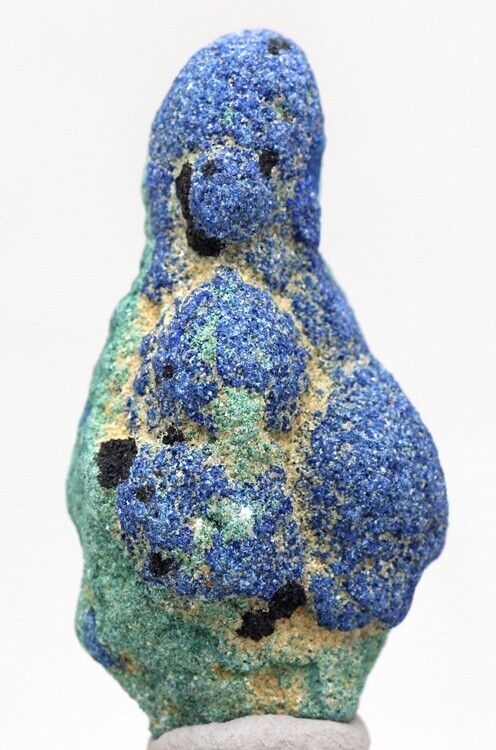
When you click on links to various merchants on this site and make a purchase, this can result in this site earning a commission. Affiliate programs and affiliations include, but are not limited to, the eBay Partner Network.

AZURITE MALCHITE NODULE Specimen Concretion Crystal Cluster Mineral UTAH:
$32.99
Click HEREto see hundreds of other amazing items for sale in my store!
This adorable specimen weighs 14.53 grams. It measures 43 mm by 23 mm by 11 mm. This is really rare as well. One thing that makes this piece really unusual is that it is a Azurite nodule with malachite in it as well! While this mine also produces malachite, it is a real treat and very unusual to see the two mineral together in ONE specimen! This is one of the most unusual and cutest pieces I’ve seen. I also think these pieces are like clouds and you can find faces and animals and also planets and earth like shapes within the perfect blue and green patterns but this one is so cool with a perfect ring of malachite around the azurite. This piece could be a planet or a Head and the blue part is the face and the green is the big bushy hair :) I photoshopped a little face to show what I see :) but you’ll probably see something different. So so cool!! :) I am selling this really neat azurite and malachite nodule concretion mineral specimen. This piece is very interesting and a totally awesome shape and there is really nothing like it. These balls are so cool. The same mine produces malachite concretion nodule balls as well and every once in a while there will be a one with both although that is very rare. I didn't want to risk breaking it open, but these little nodules are sometimes geodes with a hollow center with crystals or fibrous mineral materials. Sometimes they even have malachite centers! Or vice versa, meaning the malachite ones can have Azurite centers. This came from the Tucson Gem and Mineral show and I purchased this directly from the miner that found the stone. I love that! It is my favorite to be able to get it direct from the miner like that. This amazing concretion was found in Utah near Moab in the La Sal Mountains. I have heard that this mine sometimes allows guided tours where you can pay a fee to mine and find your own malachite and Azurite Blueberry concretions as well! I will put some more info below about malachite and azurite in general including the fact that powders from crushed azurite as well as crushed malachite which made the pigments in some of the very first paints! I actually have some fine powder azurite and malachite dust that I plan do just that with- to paint with! :) I offer a shipping discount for customers who combine their payments for multiple purchases into one payment! The discount is regular shipping price for the first item and just 50 cents for each additional item! To be sure you get your shipping discount just make sure all the items you want to purchase are in your cart. sales you win are added to your cart automatically. For any "buy it now" items or second chance offers, be sure to click the "add to cart" button, NOT the "buy it now" button. Once all of your items are in your cart just pay for them from your cart and the combined shipping discount should be applied automatically.
I offer a money back guarantee on every item I sell. If you are not 100% happy with your purchase just send me a message to let me know and I will buy back the item for your full purchase price.
Thank you for looking at my listings and let me know if you have any questions. I’d be happy to answer them.
Azurite Wikipedia’s (link stripped)
Azurite is a soft, deep blue copper mineral produced by weathering of copper ore deposits. In the early 19th century, it was also known as chessylite after the type locality at Chessy-les-Mines near Lyon, France.
The mineral, a carbonate with the chemical formula Cu3(CO3)2(OH)2, has been known since ancient times, and was mentioned in Pliny the Elder's Natural History under the Greek name kuanos (κυανός: "deep blue," root of English cyan) and the Latin name caeruleum. The blue of azurite is exceptionally deep and clear, and for that reason the mineral has tended to be associated since antiquity with the deep blue color of low-humidity desert and winter skies. The modern English name of the mineral reflects this association, since both azurite and azure are derived via Arabic from the Persian lazhward (لاژورد), an area known for its deposits of another deep blue stone, lapis lazuli ("stone of azure"). A highly sought after crystal in the world of gemstones, Azurite is known for its stunning blue color, which evolved over the millennia through reactions between copper, hydrogen, carbonate, and oxygen. Azurite features deep contrasting shades of blue, which comes from its fusion with Malachite, a closely related mineral that contains nearly the same chemistry. In crystal healing, Azurite is a gem when it comes to enhancing creativity and inner wisdom because it cleanses and activates the third eye chakra.
Azurite-Malachite is an exceptional conductor of energy, bringing a grounded, more integrated process in healing physical dis-ease. The blue ray penetrates and moves energy, calming stress levels within the system while the green ray facilitates a deep healing force. It may also be used to activate the Third Eye in cleansing the subconscious of emotionally charged thoughts or negative feelings, and restoring a higher and clearer mental state. It assists in dissolving egocentric traits, dispelling conceit, arrogance and vanity, and instills a willingness toward flexibility and individuality based on a universal connection to “All.” Azurite-Malachite’s combination of energies is highly conducive to meditation by allowing one to go deep within the self, without fear, in order to be sustained, absolved, and reborn into the light, completely aware of the genesis at all times. Azurite tempers the mind; it releases stress and confusion, and alleviates worry, indecision, and thoughts that linger in the back of the consciousness. To restore balance and control over emotions and reactions, simply hold the crystal and ask to have the troublesome thoughts evaporate. It is a rubbing stone that prefers to be touched to release its energies, so when wearing or carrying Azurite, remember to rub it often.
Azurite is a stone for connecting with sacred powers through religious music, such as Gregorian or Buddhist chants, choral music and hymns; also for healing with sound, especially using the drums, didgeridoo, pipes or the voice. The energy of Azurite is highly effective for use as a pendulum and in radionic analysis. It assists psychics, mediums, channels, or other Light workers in improving the accuracy of their interpretations and helping to maintain objectivity. Azurite stimulates all the mind centers, nourishing a keen interest in life, one’s function in society, and discovering new commonalities and links within our world. It encourages the study of new and challenging subjects, not only for school or college students, but for adults trying to fit study in with other commitments, and for “students of life” over-fifty or in retirement. Azurite enhances focus and concentration, memorization and retention of information. An excellent crystal for examinations, interviews, presentations, or negotiations, Azurite also fortifies long-term career plans, especially in large or very structured organizations. It is particularly beneficial for careers in all governmental departments, museums, libraries and universities.
Azurite is one of the two basic copper(II) carbonate minerals, the other being bright green malachite. Large crystals are dark blue, often prismatic. Azurite specimens can be massive to nodular. They are often stalactitic in form. Specimens tend to lighten in color over time due to weathering of the specimen surface into malachite.
Azurite is soft, with a Mohs hardness of only 3.5 to 4. The specific gravity of azurite is 3.77 to 3.89. The optical properties (color, intensity) of minerals such as azurite and malachite are characteristic of copper(II). Many coordination complexes of copper(II) exhibit similar colors.
Azurite is used occasionally as beads and as jewelry, and also as an ornamental stone. However, its softness and tendency to lose its deep blue color as it weathers limit such uses.
Heating destroys azurite easily, so all mounting of azurite specimens must be done at room temperature.
The intense color of azurite makes it a popular collector's stone. However, bright light, heat, and open air all tend to reduce the intensity of its color over time. To help preserve the deep blue color of a pristine azurite specimen, collectors should use a cool, dark, sealed storage environment similar to that of its original natural setting.
While not a major ore of copper itself, the presence of azurite is a good surface indicator of the presence of weathered copper sulfide ores. It is usually found in association with the chemically very similar malachite, producing a striking color combination of deep blue and bright green that is strongly indicative of the presence of copper ores.
The use of azurite and malachite as copper ore indicators led indirectly to the name of the element nickel in the English language. Nickeline, a principal ore of nickel that is also known as niccolite, weathers at the surface into a green mineral (annabergite) that resembles malachite. This resemblance resulted in occasional attempts to smelt nickeline in the belief that it was copper ore, but such attempts always ended in failure due to high smelting temperatures needed to reduce nickel. In Germany this deceptive mineral came to be known as kupfernickel, literally "copper demon".
The Swedish alchemist Baron Axel Fredrik Cronstedt (who had been trained by Georg Brandt, the discoverer of the nickel-like metal cobalt) realized that there was probably a new metal hiding within the kupfernickel ore, and in 1751 he succeeded in smelting kupfernickel to produce a previously unknown (except in certain meteorites) silvery white, iron-like metal. Logically, Cronstedt named his new metal after the nickel part of kupfernickel.
Malachite (link stripped) Wikipedia
Malachite is a green copper carbonate hydroxide mineral with a chemical composition of Cu2(CO3)(OH)2. It was one of the first ores used to produce copper metal. It is of minor importance today as an ore of copper because it is usually found in small quantities and can be sold for higher prices for other types of use. Malachite has been used as a gemstone and sculptural material for thousands of years and is still popular today. Today it is most often cut into cabochons or beads for jewelry use. Malachite has a green color that does not fade over time or when exposed to light. Those properties, along with its ability to be easily ground to a powder, made malachite a preferred pigment and coloring agent for thousands of years. Malachite is a stone of balance, abundance, manifestation and intention. Malachite absorbs energy and draws emotions to the surface. It clears and activates all Chakras, and is especially helpful in the stimulation of the Heart and Throat Chakras. An extremely powerful metaphysical stone, Malachite is often called the “stone of transformation” and is used for deep energy cleaning, bringing healing and positive transformation to the wearer. For this reason, many metaphysicians recommend using Malachite in small doses. Malachite amplifies energies of all kinds, both positive and negative. One of the most important healing stones, Malachite helps the user acknowledge, draw out, and discharge negative energy, including old emotional patterns, past traumas, and suppressed feelings. Malachite’s ability to draw out negative energy can assist in discovering the energy blocks and patterns that may be causing physical disease. Highly protective, Malachite absorbs pollution, purifies, and shields against radioactivity. Malachite can be useful in easing menstrual cramps and childbirth. Use Malachite on the Third-Eye to facilitate psychic vision, while Malachite held on the Heart Chakra will bring balance and fidelity to relationships with other people. Physically, Malachite is a wonderful equalizing and balancing agent. It protects against radiation and has been used in the treatment of asthma, arthritis, swollen joints, broken bones and torn muscles. The stone's name derives (via Latin: molochītis, Middle French: melochite, and Middle English melochites) from Greek Μολοχίτης λίθος molochitis lithos, "mallow-green stone", from μολόχη molōchē, variant of μαλάχη malāchē, "mallow". The mineral was given this name due to its resemblance to the leaves of the mallow plant. Malachite was extensively mined at the Great Orme mines in Britain 3,800 years ago using stone and bone tools. Archaeological evidence indicates that mining activity ended around 600 B.C.E with up to 1,760 tonnes of copper being produced from the mined Malachite.
Archaeological evidence indicates that the mineral has been mined and smelted to obtain copper at Timna Valley in Israel for over 3,000 years. Since then, malachite has been used as both an ornamental stone and as a gemstone. In ancient Egypt the colour green (wadj) was associated with death and the power of resurrection as well as new life and fertility. Ancient Egyptians believed that the afterlife contained an eternal paradise which resembled their lives but with no pain or suffering, and referred to this place as the ‘Field of Malachite’. The funerary mask of the Red Queen of Palenque is made from a mosaic of malachite. Malachite was used as a mineral pigment in green paints from antiquity until about 1800. The pigment is moderately lightfast, very sensitive to acids, and varying in color. This natural form of green pigment has been replaced by its synthetic form, verditer, among other synthetic greens. Malachite is also used for decorative purposes, such as in the Malachite Room in the Hermitage Museum, which features a huge malachite vase, and the Malachite Room in Castillo de Chapultepec in Mexico City. "The Tazza", a large malachite vase, one of the largest pieces of malachite in North America and a gift from Tsar Nicholas II, stands as the focal point in the centre of the room of Linda Hall Library. Malachite has also been used on the base of the FIFA World Cup Trophy. A 17th-century Spanish superstition held that having a child wear a lozenge of malachite would help them sleep, and keep evil spirits at bay. Malachite often results from the weathering of copper ores, and is often found together with azurite (Cu3(CO3)2(OH)2), goethite, and calcite. Except for its vibrant green color, the properties of malachite are similar to those of azurite and aggregates of the two minerals occur frequently. Malachite is more common than azurite and is typically associated with copper deposits around limestones, the source of the carbonate. Large quantities of malachite have been mined in the Urals, Russia. Ural malachite is not being mined at present,but G.N Vertushkova reports the possible discovery of new deposits of malachite in the Urals. It is found worldwide including in the Democratic Republic of the Congo; Gabon; Zambia; Tsumeb, Namibia; Mexico; Broken Hill, New South Wales; Lyon, France; Timna Valley, Israel; and the Southwestern United States, most notably in Arizona.


AZURITE MALCHITE NODULE Specimen Concretion Crystal Cluster Mineral UTAH $44.99

AZURITE MALCHITE NODULE Specimen Concretion Crystal Cluster Mineral UTAH $32.99
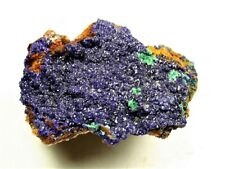
MINERALS : AZURITE CRYSTALS WITH SOME GREEN MALCHITE FROM MORENCI MINE, ARIZONA $25.00

AZURITE MALCHITE NODULE Specimen Concretion Crystal Cluster Mineral UTAH $26.99

AZURITE MALCHITE NODULE Specimen Concretion Crystal Cluster Mineral UTAH $39.99
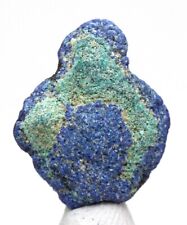
AZURITE MALCHITE NODULE Specimen Concretion Geode Ball Crystal Cluster Mineral $11.99
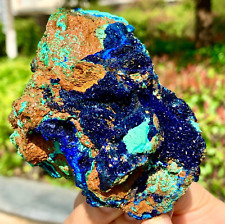
367G BEST NATURAL Azurite/Malachite crystalminerals specimens $261.00
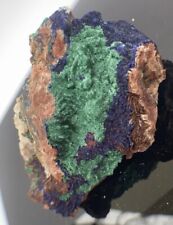
115 Gram BEST NATURAL Azurite/Malachite On Rare Barite & Quartz Matrix Specimen $93.10
|